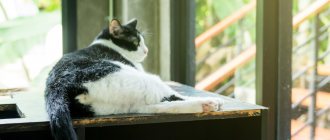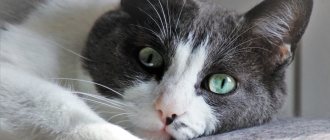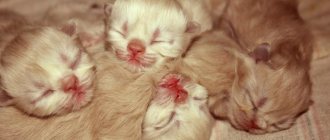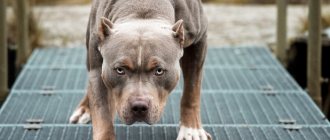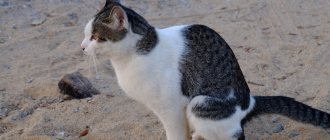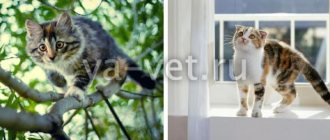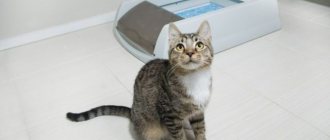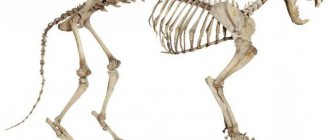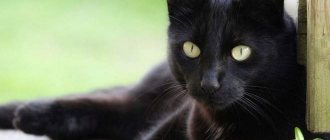Coughing is a protective reaction of the cat’s body from foreign objects that enter the respiratory tract, esophagus or stomach. Coughing can also be caused by hairballs in the stomach, inflammatory processes in the respiratory system, attacks of allergies or bronchial asthma.
If the owner notices that the cat is choking and coughing, as if it has choked, immediate measures must be taken to save the animal from suffocation. Let's find out why a cough occurs and how to independently help your pet before the veterinarian arrives.
Mechanism of cough development
A periodically occurring cough in a cat may indicate the development of inflammatory processes in the respiratory system, which require long-term treatment under the supervision of a veterinarian. It can also occur when trying to get rid of hairballs that accumulate in the animal’s stomach.
However, if the cat spontaneously begins to cough, wheeze, stretch out and press itself to the floor, this most often indicates ingestion or inhalation of small foreign objects. In this case, the animal must be quickly assisted or taken to the clinic without delay.
A cough is a strong, accelerated exhalation through the mouth, which occurs due to a sharp contraction of the muscles of the respiratory tract as a result of irritation of the receptors. In this way, the cat's respiratory tract is freed from mechanical substances that impede the movement of air along the airways.
The cough algorithm consists of the following stages:
- take a deep breath for no more than 2 seconds;
- reflex contraction of the smooth muscles of the larynx, which closes the glottis;
- increased tone of the bronchial muscles;
- sharp contraction of the abdominal muscles;
- opening of the glottis;
- a powerful exhalation that expels foreign agents.
Types and symptoms of cough in cats
The classification of cough in cats is described in detail in the table.
| Characteristics of cough | Degrees and types of cough manifestations |
| Force | slight cough; hacking cough |
| Form depending on duration | acute (less than 14 days); prolonged (from 14 to 45 days); chronic |
| Timbre | silent; voiced; deaf; hoarse; hoarse; barking |
| Presence of discharge | dry; wet |
| Character of sputum | serous; slimy; purulent; mixed with blood |
| Development time | constant; seasonal |
Symptoms that most often accompany coughing in cats include:
- discharge from the nasal cavity;
- vomit;
- wheezing.
The nature of the cough helps specialists make the correct diagnosis, identify the causes and prescribe appropriate treatment for a coughing cat.
Main causes of cough in cats
Veterinary experts identify 6 main causes of cough in cats.
- Bronchial asthma. This is one of the types of allergies that occur in a cat to foreign components that can be contained in dust, pollen, hair from other pets, dead particles of human skin, as well as in medications and chemicals.
- The presence of foreign objects in the upper respiratory tract, esophagus or stomach.
- Pathologies of the cardiovascular system.
- Helminthic infestations. During migration, Toxocara larvae enter the lungs. This most often occurs in young animals due to untimely deworming after weaning. In this case, the kitten coughs heavily and may vomit a foamy mass in which parasites are found. The cat may also cough constantly due to the presence of heartworms in the pulmonary arteries. These thin, long helminths parasitize the heart, pulmonary artery and small capillaries. They clog blood vessels, which causes frequent severe coughing, vomiting, shortness of breath, loss of appetite, and in case of severe infestation, convulsions and death.
- Infectious diseases of the upper respiratory tract. The most common diseases include herpes, rhinotracheitis and calicivirus.
- Pneumonia. The etiological factors for the occurrence of pneumonia in cats are pathogenic bacteria, viruses, microscopic fungi, as well as external factors such as hypothermia, eating cold food, and keeping the animal in unsanitary conditions.
- Malignant tumors in the respiratory organs.
Important! Among infectious agents, a special place is occupied by the pathogenic bacterium Bordetella bronchiseptica, which causes bordetellosis. Most often, this disease is transmitted by airborne droplets when cats are kept in crowded conditions in nurseries. The infection is also spread by stray cats, which can infect free-roaming pets.
If the cat is coughing heavily and breathing heavily, then the cause of this condition may be pneumo- or hydrothorax, caused by the penetration of air or liquid into the chest cavity.
Limb dysfunction in a cat
Have you started to notice that your pet is stretching its hind legs, its gait has become uncertain, and instead of making graceful jumps, the cat clumsily misses, breaks down and falls from a height (what to do if a cat has fallen from a height)? Has your pet begun to frequently stretch out its hind legs and meow pitifully at the same time? Besides, do your attempts to stroke his spine and tail often end in very aggressive behavior on the part of the cat? Do not rush to think that the problem is only an injury to the spine or hind legs - the cat could have received them while jumping earlier. The cause may also be internal violations. And we will tell you more about them and their symptoms right now. But first, let's decide what examinations the animal needs to undergo, what tests to take, in order to diagnose the cause of impaired limb mobility in a cat.
Diagnosis of the condition
The multiplicity of causes that can cause cat cough makes it very difficult to diagnose cats. Therefore, the veterinary specialist consistently conducts a series of studies, including:
- collection of anamnestic data;
- inspection;
- palpation;
- percussion;
- auscultation;
- general and clinical blood test;
- radiography;
- coprogram for identifying intestinal helminth eggs.
If it is not immediately possible to determine the reason why the cat cannot cough, the veterinarian will prescribe additional laboratory and instrumental tests.
Note! Only large veterinary clinics can afford additional research, and the cost of these services is quite high. Therefore, it is advisable to carry them out more often for such high-pedigreed “expensive” cats as Sphynx, Maine Coon, Peterbald, Scottish Fold and others.
Specific additional studies that will help determine exactly why a cat is coughing with wheezing include:
- sputum analysis for the presence of viral agents and their identification;
- fluoroscopy of the esophagus using a contrast indicator;
- endoscopy of the upper respiratory tract and esophagus;
- bronchoalveolar lavage (performed under general anesthesia).
If the doctor suspects that the cat cannot cough due to the development of pathology of the cardiovascular system, the doctor will prescribe an ECG or ultrasound of the heart.
Diagnosis of the causes of limb dysfunction in cats
A veterinarian must diagnose a cat.
In order to determine which of the following reasons is relevant in your case, you should, of course, seek advice from a veterinarian at your nearest veterinary clinic. After examining your pet, the specialist will probably prescribe you to donate the cat’s blood, its urine, and also do an ultrasound of the pet’s internal organs and an X-ray of the spine (more about tests for animals). Thanks to the results of this minimum package of examinations, it will already be possible to draw the first conclusions about the causes of this disorder, and accordingly talk about the treatment of the disease.
How to treat cat cough
If a cat is coughing, it can be treated at home only after being examined at a veterinary clinic, making an accurate diagnosis and prescribing appropriate therapy.
You should not self-administer cough suppressants before visiting a doctor, as this may change the clinical picture of the disease and make it difficult to determine the cause of the pathology.
Important! If the cat is coughing and wheezing, as if he is choking, then you should not take any independent action. It is better to quickly take your pet to the hospital or call a doctor at home. Delay can also be fatal when the cat wheezes, trying to burp, but only spits up saliva or foamy liquid.
If a cat coughs due to an infectious disease of viral etiology, the doctor prescribes:
- antibacterial drugs (Amoxisan, Sinulox, Tsiprovet) to prevent the development of secondary bacterial infections;
- mucolytic and expectorants (Bromhexine, licorice extract);
- immunomodulators (Cycloferon, Fosprenil, Maxidin);
- globulin Vitafel;
- intravenous injections of Ringer-Locke solution or saline with 5% glucose (to prevent dehydration when refusing food).
If the cough is accompanied by wheezing and the cat coughs while stretching its neck, then the cause may be pneumonia or another inflammatory process in the respiratory system. In this case, antibiotics are first prescribed. And to relieve coughing, the cat should be given antispasmodics, mucolytics and expectorants.
If a cat's cough is accompanied by vomiting, this often indicates helminthiasis. In this case, anthelmintic drugs are prescribed (Pyrantel, Prazicide, Drontal, Milbemax). Despite the fact that these medications are sold in pharmacies without a prescription, you should not use them yourself if your cat wheezes and tries to burp.
In case of severe infestation, an incorrectly selected dosage can lead to excessive activity of parasites and lead to suffocation. Illiterate actions by owners can also lead to intestinal rupture or excessive intoxication in small kittens.
If the reason that the cat is coughing and stretching its neck, as if choking, is trichobezoars, then the doctor will prescribe special pastes and gels to remove or dissolve hairballs in the stomach.
If a cat coughs and wheezes with its tongue hanging out, this may indicate an attack of bronchial asthma. You can quickly relieve an attack with:
- glucocorticosteroids (Hydrocortisone, Prednisolone, Dexamethasone, Fluocinolone);
- bronchodilators (Theophylline, Atropine);
- antibiotics (if there is a threat of infection by pathogenic bacteria).
Important! Self-administration of glucocorticosteroid and bronchodilator drugs to treat Sphynxes and other cats when they cough while stretching their necks can lead to overdose, complications and the development of side effects. Therefore, you should not put your pet’s life at risk; you must urgently take him to the clinic.
The reason that the cat is coughing, wheezing, as if he is choking, may be a heart attack, which develops in the cat as a result of a hidden pathology of the cardiovascular system. In this case, any independent treatment is unacceptable.
You should immediately call the clinic, call a veterinary specialist to your home and get a recommendation on the actions that need to be taken before his arrival.
Why do cats roll on the ground?
Why do cats roll on the ground?
Who among us has not seen (especially on a fine summer day) how a dazed cat, for no apparent reason, falls to the ground and begins to roll from side to side. It's funny to watch from the outside! It’s probably more difficult for the owners: they already have a clear idea of how much not entirely useful stuff will be collected in the animal’s fur and subsequently brought home. But nothing can be done - the costs of cat behavior!
By the way, our regular readers will remember that we, together with our colleague AmiShojai, asked this question not so long ago. But the restless Amir decided to complement herself!
Let's see: in what cases does your cat exhibit this behavior? The fact is that not all animals are allowed outside! Stretch your memory, dear cat lovers, and try to imagine all the situations associated with “turning over” pets on their backs. Are you getting ready for work and your cat is rolling around on the floor? She just doesn't want you to leave, she asks you to stay and play with her if possible.
Does a cat ride on its back, as they say, out of context, that is, on its own? It's okay - she does a kind of self-massage, scratches her back.
Is something similar happening on the street? Yes, and this is also self-massage!
But cats don’t just “roll”, otherwise they would never be cats! At the same time, they mark the territory and indicate that the place is occupied.
True, it should be emphasized that cats lie on their backs, being, as a rule, in high spirits. Notice how the rolling cat's face radiates calm and contentment.
There is one more, this time physiological, feature: cats tend to lie on their backs before and after mating during an interesting period.
But, be that as it may, in ordinary, home conditions, having noticed a cat riding on its back, you can conclude to yourself that the animal wants to attract attention.
We are forced to warn not very experienced cat lovers: a cat lying on its back and showing off its fluffy belly is by no means inviting you to pet it! Do not give in to the temptation to pet the cat where she doesn’t really like, otherwise your pet’s good mood will quickly disappear! You're unlikely to get away with just scratches...
And cats should not be confused with dogs! A dog lying on its back, in the vast majority of cases, demonstrates complete submission and submission. And a cat, you know, is an animal that lives on its own!
A cat rides on its back: signs
Experienced cat owners know that many mustachioed tabby cats love to lie on their backs. There are a great many reasons for this behavior: from skin problems to the desire to please yourself and relax too tense muscles.
However, rolling on the floor or clothes of the owner cannot always be explained from a physiological point of view. It should be remembered that a cat is a very sensitive creature and has a lot of mystical abilities. Therefore, sometimes a strange and at first glance uncomfortable posture can serve as a warning. So what is the furry pet, raising all four paws to the sky, in a hurry to notify its owner about?
- Many people know that any purr is a real personal meteorologist who accurately predicts weather changes. If your pet lies upside down in the winter cold, then you can be sure that a strong snowstorm will soon break out outside. The cat rolls selflessly on the ground (floor) in spring or summer - beware of getting caught in the rain.
- Another “weather” sign says that if a cat keeps turning over on its back in a dream, you should expect the thermometer to creep up. In winter and spring this means an unexpected and strong thaw, and in summer it means unbearable heat.
- If your pet rolls selflessly on the floor, and at the same time meows desperately, then start preparing a treat. After all, the fluffy one knows for sure that a noisy group of friends is rushing to visit you.
- When there is a sick person in the house, the cat will tell you about his well-being. An animal nestled next to an ailing family member? It greatly helps fight illness, which means there is hope for recovery. It is much worse if the pet has left the sufferer’s bed and is lying on its back under the table. So he makes it clear that nothing can be done, and all that remains is to wait for death.
How to understand that a cat is not just coughing, but choking
If a cat coughs, wheezes and at the same time stretches out, pressing her whole body to the floor, then in 99% of cases this indicates that a foreign object has entered the esophagus or respiratory tract. When a cat coughs as if he is choking, you should not do anything on your own. You should immediately take your pet to the clinic.
Sometimes the cat gags and coughs, as if he wants to vomit, but attempts remain to no avail. This may indicate that the pet is unable to get rid of a large trichobezoar in the stomach on its own.
If the cat coughed, as if she was choking, but quickly came to her senses, then there is no reason to worry, as she could simply have choked.
How to help a cat who is choking
If, after eating fish or tubular bones, the cat sticks out its tongue, coughs, wheezes, or simply sits with its mouth slightly open, then there is a high probability that a sharp bone is stuck in its throat or esophagus.
If you have experience with animals, you can try to remove it yourself. But this can only be done if the bone is clearly visible in the oral cavity. To do this, you need to secure the cat. Then ask an assistant to hold the animal and try to open the pet's mouth wide.
The next step is to remove the bone using tweezers.
If the cat coughs, wheezes, or sticks out its tongue and makes wheezing sounds, but upon examination a foreign object cannot be detected, then the animal should be taken to the doctor immediately.
Why does a cat like to lie on its back?
It is no secret that to sleep, animals take the most unrealistic, sometimes hanging, poses and places that are not at all suitable for this matter: radiators, trees, flower pots, the owner’s face.
Table 2. Favorite cat sleeping positions
| Popular name | Body position | |
| Incognito style | The pet curled up into a ball, hiding its hind legs and muzzle. Often the ears and tail are flattened | With this pose, cats intuitively protect their vulnerable areas: the throat and stomach. If your pet often curls up in its sleep, this does not mean that it is wary and does not trust anyone, it is just another effective way to keep warm. |
| Fetal position | The pet will curl up, tucking one paw. The other three are in a free position | By examining a cat sleeping on its side, you can understand whether it is left-handed or right-handed. This depends on the tucked paw, since it is a pushing one. As a rule, for left-handers, the pushing paw is the right one, and vice versa |
| Horizontal version | The pet is spread out at full length, lying on its side | This position is similar to the position of the body on its back, when the animal is as relaxed as possible and immersed in deep sleep. |
| Emperor style | The pet lies on its back with its paws stretched up | The most attractive cat sleeping position due to maximum muscle relaxation |
Habit since childhood
The funny pose was imprinted in the memory of predators at that stage of their life when their eyes barely opened. It is known that small kittens spend about 65% of their time in REM sleep. During these few months after birth, they are carefully licked by their mother’s tongue while the kittens bask under her warm fur.
Sleeping on the back is common for both kittens and adults.
These moments of calm and bliss are presumably stored in the pet and manifest as rare (or frequent) episodes in the cat's adult life. Returning to the “roots” allows animals to feel like carefree and happy kittens again.
Confidence
Just like for dogs, for cats, exposing their belly is a sign of friendliness. If a domestic animal is sure that it is absolutely safe, feels protected in a familiar environment with people it knows, then it can allow itself to roll over on its back and even fall asleep like that.
A cat can only allow itself such a vulnerable pose when surrounded by its closest ones.
At the same time, everything can change if new people appear around the pet. A cat, sensing an unfamiliar smell, strives, at a minimum, to protect itself with a more modest pose, wake up, or even run away to another place.
Comfort
When cats bend in a bizarre way and sleep soundly, you should not find a hidden meaning in this, call the doctor or forecast the weather. Basically, for pets, this position simply seems convenient. You shouldn’t deliberately turn them over and make them “the best way.”
Cats do not make unnecessary movements - if they have chosen this position, then it is the most comfortable
Need for affection
It is not difficult to understand what the insidious cat wants when it begins to sway and stretch, touching observers with its flexibility and grace. The animal thus demonstrates its humility and offers to immediately, before it changes its mind, gently and efficiently scratch its belly. For outsiders, displays of such emotions are rare, although in many cases it depends on the animal’s personal attitude towards people.
Sometimes the cat's bizarre pose is addressed to the owner and is a call to play
Attention! In the matter of affection, you should remain careful, since the graceful poses of a cat cannot always be regarded as an invitation to touch the beautiful. The stomach is the weak spot of any animal. For invading a cat's personal space, the punishment may be a blow with a clawed paw or a bite, which is a manifestation of a natural protective instinct. This rule of “mood” applies to absolutely everyone, both our own people and strangers, regardless of whether the cat is tamed or not.
When showing affection, be prepared for the fact that your pet may quickly change his mood
If anyone is interested in why cats roll over on their backs and pull their hands with their hind legs, then the answer is simple: this is inherent in their subconscious by nature itself. Similar behavior can be observed in the wild relatives of domestic cats: they do this to their prey, finishing it off, trying to rip open its stomach. In the case of domesticated pets, these traces of the hunting heritage remain intact.
Heat
Often it is the stuffiness that “falls” kittens onto their backs, forcing them to spread their paws in different directions, because with an open belly the body cools down faster. It is difficult for a person to understand this type of behavior, because at first glance, all cats, with the exception of some breeds, are equally fluffy in all places.
It is customary that the standard indicators of a cat’s body temperature are higher than the human norm. Even during the molting period, the fluffy coat begins to fit more tightly to reduce the air space that traps heat.
Lying on its back, the cat tries to lower its body temperature by airing its undercoat
In the hot summer, cats move to the floor even from the soft, barely occupied master's bed, because on the floor it feels cool. But such measures are not enough for cooling. Heat exchange in the abdominal area occurs faster, since there is less hair there, so cats “ventilate” by turning over on their backs.
Puberty
Discomfort in the groin caused by the desire of an uncastrated cat serves as another answer to the question that interests us. This revealing position helps ease the male's discomfort due to arousal. A person can only wait until the “March” period ends, or find a partner for the pet to mate with.
Binge eating
Tailed lovers of food and sleep have a habit of manipulating people by begging for food. Everything is used, from charisma to undisguised arrogance. Such manipulations sometimes backfire on pets: uncontrollable cat greed and boundless human generosity lead to overeating of the animal.
For overweight cats prone to overeating, sleeping on their back is the only way to rest without squeezing their stomach.
Having had enough, the pet craves only rest. And then he is faced with a problem: curling up into a ball or lying on his paws is painful and uncomfortable. Depending on the degree of overeating, he has to fall on his side or back so that nothing is squeezing his stomach.
Whenever possible, limit your pets from unauthorized access to food.
No matter how funny it may look, the gastronomic issue is not to be joked about. The owner, one way or another, takes responsibility for the one he has fed and tamed, so he must wisely calculate the proportions, making the cat’s diet balanced. If you are having difficulty weaning your pet from trying to eat the owner's food, below are some recommendations for pacifying the gourmet.
We stop the cat from begging for food
Other ailments
For a loving owner, his guests and just random passers-by, a cat resting on its back is a touching sight, a reason to take out a camera for a souvenir photo or to cuddle the animal until it recovers from sleep. Moving on to the planned actions, few people suspect about the health problems of the pet, due to which he selects this particular position.
In addition to behavioral characteristics, various diseases can also be the cause of sleeping on your back.
If sleeping on your back is a sign of illness, it will be accompanied by some of the following signals:
- the pet becomes restless;
- cannot find a place for himself;
- meows often and loudly;
- eats less often;
- cannot go to the toilet or does it too often.
If the cat behaves aggressively during palpation, then it is necessary to identify the source of pain
In this case, a visit to the veterinarian will not be unnecessary. Most likely, your pet may have:
- Digestive tract problems;
- Disease of the genitourinary system;
- Ailments in the groin and other inflammations.
Often, a sick animal does not allow itself to be touched, and when palpation is attempted, even the kindest domestic animal unexpectedly responds with aggression. You can find out more about cat diseases on our portal.
The cause of diseases associated with the inability to lie on the stomach is most often disturbances in the gastrointestinal tract.
If the cat’s tests indicate the absence of pathologies, then the reason for sleeping on the back is one or even several of the above points.
Sometimes, sleeping with their belly up, animals sniffle and even quite literally snore. This is not a symptom of pulmonary or heart failure unless the pet suffers from shortness of breath, poor appetite and inactivity when awake. Otherwise, housewives have nothing to worry about: the nasal septum in an uncomfortable position is slightly depressed, as happens in a person during snoring.
Preventive measures
To minimize the risk of a hoarse cough in cats, you need to adhere to the following rules:
- promptly vaccinate the animal against infectious diseases;
- carry out regular treatments against helminths and skin parasites;
- brush the hair of representatives of long-haired breeds daily;
- periodically feed gels and pastes to remove hair from the stomach;
- prevent pets from hypothermia;
- strictly observe the rules of cat hygiene and ensure high-quality living conditions;
- Do not feed your cat raw river fish and tubular bones.
If, however, a situation arises in which the cat begins to cough, wheeze and cling to the floor, then you should immediately go to the veterinary clinic. Specialists will quickly find out the causes of these symptoms and provide qualified assistance.

